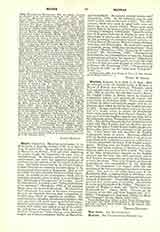

Mayer , CHRISTIAN, Moravian astronomer, b. at Mederizenhi in Moravia, August 20, 1719; d. at Heidelberg, April 16, 1783. He entered the Society of Jesus at Mannheim on September 26, 1745, and after completing his studies taught the humanities for some time at Aschaffenburg. He likewise cultivated his taste for mathematics, and later was appointed professor of mathematics and physics in the University of Heidelberg. In 1755 he was invited by the Elector Palatine Charles Theodore to construct and take charge of the astronomical observatory at Mannheim. Here as well as at Schwetzingen, where he had also built an observatory, he carried on his observations which led to numerous memoirs, some of which were published in the “Philosophical Transactions” of London. One of his observations, recorded in the “Tables d’aberration et de mutation” (Mannheim, 1778) of his assistant Mesge, gave rise to much discussion. He claimed to have discovered that many of the more conspicuous stars in the southern heavens were surrounded by smaller stars, which he regarded as satellites. His contemporaries, including Herschel and Schroter, who were provided with much more powerful telescopes, failed to verify his observations. Mayer, however, defended their reality and replied to one of his critics, the well-known astronomer Father Holl, in a work entitled “Grundliche Vertheidigung neuer Beobachtungen von Fixstern-trabanten welche zu Mannheimauf der kurfurstl. Sternwarte endeckt worden sind” (Mannheim, 1778). In the following year he published a Latin work on the same subject. The observations, which were made in good faith, were evidently due to an optical illusion. Mayer spent some time at Paris in the interests of his science, and visited Germany in company with Cassini. Upon the invitation of Empress Catherine of Russia, he went to St. Petersburg to observe the transit of Venus in 1769. He was a member of numerous learned societies, including those of Mannheim, Munich, London, Bologna, Gottingen, and Philadelphia. He published a number of memoirs, among which may be mentioned “Basis Palatina” (Mannheim, 1763), “Expositio de transitu Veneris” (St. Petersburg, 1769), “Pantometrum Pacechianum, seu instrumentum novum pro elicienda ex una statione distantia loci inaccessi” (Mannheim, 1762); “Nouvelle mcthode pour lever en peu de temps et A. peu de frais une carte generale et exacte de toute la Russie” (St. Petersburg, 1770); “Observations de la Comcte de 1781” in the “Acta Acad. Petropolit.” (1782), etc.
HENRY M. BROCK

